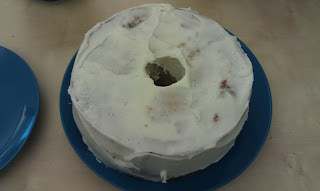Side note: Kinda thinking I should have just gone with 'Bake,' for the blog post, first three posts are about baking.
On Surface Area and Volume
The ration of surface area to volume (crystal size) has a large effect on the flavor of food. This is especially true of foods which are of the same general form, but with different physical characteristics. Generally speaking, the most common ingredients with such variations are sugar and salt. For example, most of us are familiar with both confectioner's sugar and the standard granulated sugar. Despite the huge difference in flavor and cooking properties, the primary difference between the two types of sugar is crystal size. If you have a good blender, you can even convert granulated sugar into confectioner's sugar.
We will first examine the time when this effect matters, and then discuss how to take advantage of it in your own cooking.
When it matters
The main reason that they physical structure of our food has an effect on the flavor is because it strongly influences the reaction rate either between ingredients (during cooking) or between the food and our taste buds (during eating).
To examine the effects of surface area and volume during cooking let us consider the case of crushed vs. whole red peppers. While both add flavor and heat to a dish, the flavor from whole peppers is much more controllable than that from crushed peppers. The main reason for this is that the whole peppers disperse their flavor much more slowly than the crushed pepper which is mixed into the dish. If cooked for a short period a dish using whole peppers will still be subtly spicy, but the peppers themselves will still be quite intense (and the diner can choose to eat them, or not). However, if the cooking period is longer, the difference between whole and crushed peppers will be much less, and the whole peppers will retain much less of their original flavor.
A good way to examine the effect of reaction rate during consumption is to think about the difference between eating confectioner's sugar and rock candy. Both are more or less pure sugar, but confectioner's sugar is many tiny crystals while rock candy is effectively a single large crystal. Because of this difference confectioner's sugar is so sweet it almost can't be eaten (at least in quantity), however man people will bite into rock candy rather than sucking on it until it is dissolved.
How to take advantage of it
As indicated in the examples, you can use crystal size to modify the flavor of your food either during cooking or during eating. To take advantage of it during cooking, you can either influence the amount of flavor in the dish by using short cooking times and large ingredients which can later be removed (whole cloves, cinnamon sticks, bay leaves, whole peppers etc), or change the distribution of flavors in the dish for a later effect during eating (whole fruit, flavor crusts etc). To influence flavor during eating you can either increase the intensity or separate a flavor for a multi-stage flavor experience by moving flavors out of the body of the food to the surface, or focusing the flavors into subsections of the food (what I like to call flavor bursts).
In future posts I will both provide recipes which explore many of these effects, and discuss additional differences between different types of flours, sugars, and salts.


























